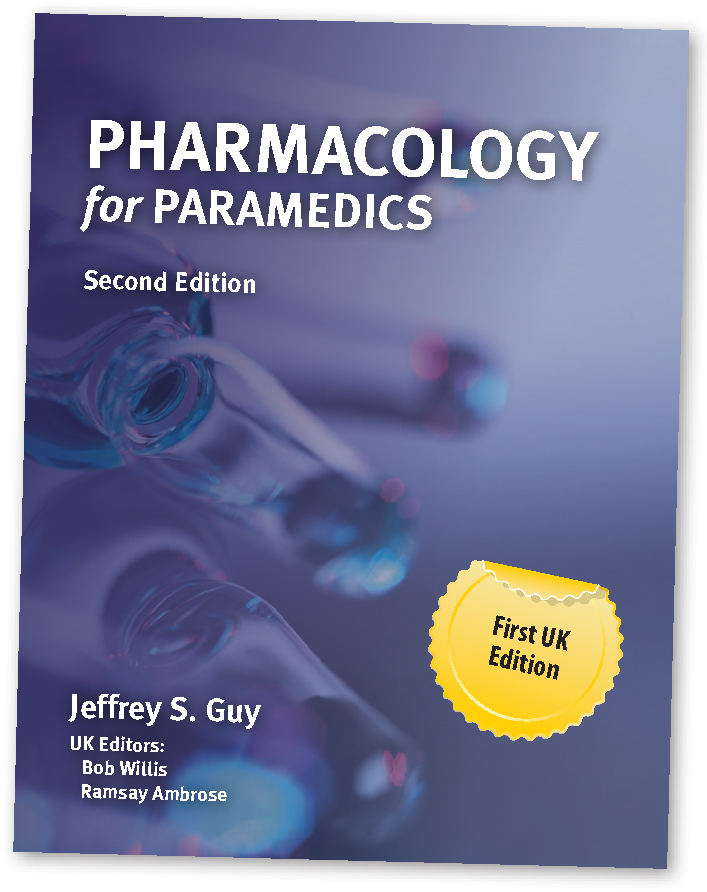As someone who recalls agonisingly learning JRCALC drug dosages, cautions and (contra-) indications off by heart during my undergraduate paramedic degree, I was not particularly looking forward to the idea of reviewing a pharmacology book. However, the introductory paragraphs of Pharmacology for Paramedics seemed like they were written for someone just like me and put my worries at ease. The authors start off with a detailed case study and draw the reader in to actively consider the appropriate clinical decisions and treatment plan by asking poignant questions. However, they then ask the reader not to approach pharmacology as a topic that requires memorisation of a multitude of facts and dosages— but rather to view it as an opportunity to synthesise and apply all prior learning on anatomy and physiology, as well as disease management. They ask the reader to stop and reflect upon how they would apply what they are reading in a patient encounter. Now that sounds far more interesting and relevant than learning things off by heart! Compliments to the authors for getting me to open my mind to this topic—if nothing else, I have a slightly more positive view of pharmacology.

At nearly 1 kg in weight, Pharmacology for Paramedics is certainly not a pocket book; however, its 450 pages are jam-packed with information offering complete and practical understanding of pharmacology in the prehospital setting, which probably goes beyond the capacity of a pocketbook anyway. Pharmacology for Paramedics uses a problem-based approach to not only ensure that readers are prepared to effectively administer the drugs their patients need, but also to have a broader understanding of the prescribed and over-the-counter medications their patients may be taking routinely. This is especially important given that most call-outs for ambulance services involve patients with complex health conditions, comorbidities and polypharmacy.
The three authors of this book are all paramedics, with two of them being from the UK. None of the main authors are pharmacologists, but one is a paramedic lecturer with a teaching focus on pharmacology, and this first UK-edition has been reviewed by a retired pharmacist and an ambulance service head of pharmacy—certainly a group of people with relevant expertise of pharmacology for paramedics.
The first five chapters focus on ‘Foundations’ and cover principles, legal aspects, drug administration, medication maths and intravenous fluids. The next part of the book covers ‘Problem-Orientated Pharmacology’, with each chapter covering a different clinical topic. Examples of topics include acute coronary syndromes, anaphylaxis, endocrine emergencies, overdoses, seizures and shock.
Throughout the book, each chapter begins in a very structured way with chapter objectives, a list of medications that will appear in the chapter, the main content (including case studies highlighted using a light green box), a chapter summary, review questions and references. Whenever a new medication is introduced, this is presented in a purple table providing an overview of the drug's classification, action, indication, adverse effects, contraindications, dosages and special consideration. Whenever a route of administration is discussed, this is presented in an orange table displaying the equipment needed and describing the procedure. Illustrations are in colour, and are detailed, clear, relevant and informative. It is great to see older adults portrayed when illustrating conditions mainly encountered within this demographic (e.g. congestive heart failure).
The book finishes with an extensive collection of appendices covering: medications, classifications and the affected body system; drug profiles; commonly prescribed and over-the-counter medications and common herbal supplements. The compilation of drug profiles is especially useful as it combines all the aforementioned helpful purple boxes in alphabetical order. The exception to this was the section on ‘statins’; statins were listed under ‘H’ corresponding to their classification of ‘HMG-CoA reductase inhibitors’, which was slightly confusing. Conveniently, the medication lists also include trade names, which may be more frequently used by patients (e.g. Depakote – divalproex, Prozac – fluoxetine, Humulin – human insulin). I'd also warn keen readers not to leaf through to the back of the book like I did; in addition to the brilliant index which makes it extremely easy to look up specific topics, medications, patient conditions and even figures, readers will also find answers to each chapter's review questions.
In light of many UK paramedics nowadays working in diverse settings such as primary care, community services or acute hospitals, it should be noted that this book is primarily aimed at paramedics, who work in the ambulance service setting. In fact, the preceding US-edition was titled Pharmacology for the prehospital professional, which makes this fact even more clear. That is not to say however that paramedics working outside of an ambulance service setting could not learn something from the book—they would likely just have to supplement their learning with some additional textbooks relating to pharmacology in their setting and focused on their patient demographic.
In conclusion, this is a book that I would have found useful as an undergraduate paramedic student as it may have prevented me from thinking that pharmacology was only about memorising facts and dosages. I would have also found it useful as a newly qualified paramedic— particularly the sections about commonly prescribed and over-the-counter medications. However, even for someone who has been a paramedic for quite a while, this is a great book to use as a refresher of your knowledge of pharmacology and as a reference book when reflecting on how to manage one of those tricky patients who has a prescription list as long as their arm.

